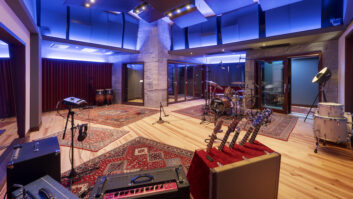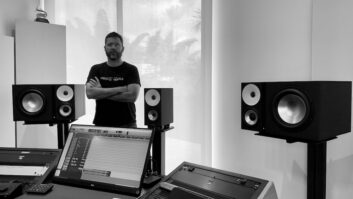
Cream, a new large-scale recording studio complex in West London, recently opened with a custom ATC (Acoustic Transducer Company) 5.1 surround reference monitor system installed in the main control room. The system comprises three ATC SCM300 ASL Pro speakers for the left/center/right channels, a pair of SCM150 ASL Pro monitors handling the surround channels, and two SCM 0.1/15 subwoofers for LFE. The ATC P4 850-watt amplifiers, normally built into the cabinets, are all remotely located.
Cream’s chief engineer, Chris Dibble, designed the studio in consultation with Roger D’Arcy of internationally renowned Recording Architecture Ltd. (For more on D’Arcy’s work, read the Mix Interview story from the August 2007 issue.) Dibble, who was studio manager and chief engineer at Lansdowne Studios for more than 30 years, until Lansdowne closed in 2006, has a long history with ATC monitors. “I wouldn’t choose anything else, frankly,” Dibble says. “Unlike some other makes of monitoring that I find colored, with these you hear exactly what you have. And the imaging is absolutely superb.”
Dibble has worked on commercial and film projects, including such films as Billy Elliot, Captain Corelli’s Mandolin, Chocolat, Notes on a Scandal, Shakespeare In Love and The Talented Mr. Ripley, and recorded and mixed the multi-award-winning score for last year’s La Vie En Rose. Dibble has years of experience with ATC reference monitors. “I’ve known [ATC founder and technical director] Billy Woodman for a long time,” he says. “We first put ATCs in Lansdowne in 1987 or 1988. We subsequently put ATCs into more builds that we did. We owned a company called CTS Studios and we put ATCs into Studios 1, 2 and 3, and the three mastering rooms.”
There have been a number of opportunities to work on the ATC system since the studio opened just a couple of months ago, says Dibble. “My main work is in film. I have a movie that I’m starting that I’m recording elsewhere then mixing at Cream. I did another film four or five weeks ago that I recorded at AIR [Studios] and we mixed at Cream.”
The facility’s two-story, 850-square-foot live room, which incorporates adjustable acoustics and two isolation booths, will accommodate about 20 musicians, depending upon the lineup, according to Dibble. “I did a commercial in there with a big band and they were all knocked out by it, particularly the sound in the control room. The ATCs are doing their job!”
The performance of the custom ATC surround monitoring system at Cream is further assured by the design of the 405-square-foot control room, which avoids the acoustic and technical compromises imposed by positioning a window between the mixing console and the live room. “It’s a fabulous control room with beautiful proportions. There are no windows anywhere, effectively, which is a plus factor from the point of view of the acoustics,” explains Dibble.
The Cream complex, which is owned and operated by Richard and Louise Eastwood, also incorporates six white rooms—two large and four medium-sized rooms, all with overdub booths —that may be equipped according to client needs for programming, pre-production or post-production use. GearBox, which the Eastwoods launched in 1997 and has since grown into one of Europe’s leading audio/video equipment rental and sales companies, is headquartered in the same building as Cream and offers 24/7 technical support.
“Because of the whole concept of Cream, which ties all the white rooms into it, we decided that we didn’t want any visual contact between the control room and the live room,” elaborates Dibble. “If the white rooms are using the live room there could be a privacy issue. Hence, we put the booth on the left-hand side of the control room. It has its own private space, but the live room can be used by the white rooms or completely on its own.”
For more information, visit www.lasvegasproaudio.com, www.atc.gb.net, www.creamrecordingstudios.com and www.aaa-design.com.







